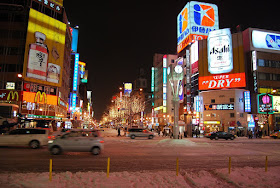I never did find party hats there, though I did make a different discovery. In the back of the second floor, near the black light stuff, feather boas and Zippo lighters, were designer purses behind locked glass cases. The brand names were plastered everywhere on signs in big bubble letters — Louis Vuitton, Prada, Coach. And perhaps just as prominently displayed as those luxury digs were the price tags.

Let me do the math for you. Using today's conversion rate of $1 = 94 yen, looking from left to right:
- 89,800 yen / 95,900 yen = $948 / $1,013
- 142,900 yen = $1,509
- 245,900 = $2,598
- 128,000 yen = $1,352
It's no secret that the Japanese love luxury goods. I've read articles claiming that one in three Japanese women owns a Louis Vuitton purse. Talk about the watering down of a luxury brand — if practically everyone owns an absurdly overpriced piece of designer garbage, are you really so special or stylish anymore for owning one? Especially when they're selling them at Odd Lots? I mean, even if these things are somehow deeply discounted, who drops thousands of bucks on a purse from Odd Lots? Odd Lots, people! I don't get it. If you're going to cheat and buy the purse at Donki, why not just find a knock-off somewhere for $50?
Though, it does appear that these bags may be sitting on the shelf for a while. According to this ABC article, last December the economic downturn (which has smacked Japan twice as hard as the States) forced Louis Vuitton to cancel its plans to build a mega-store in Tokyo. Oh no, God! No extra super mega warehouse of sickeningly extravagant precious turd-colored purses! The humanity!
Hmm! Maybe the recession actually is making the world a better place.
































